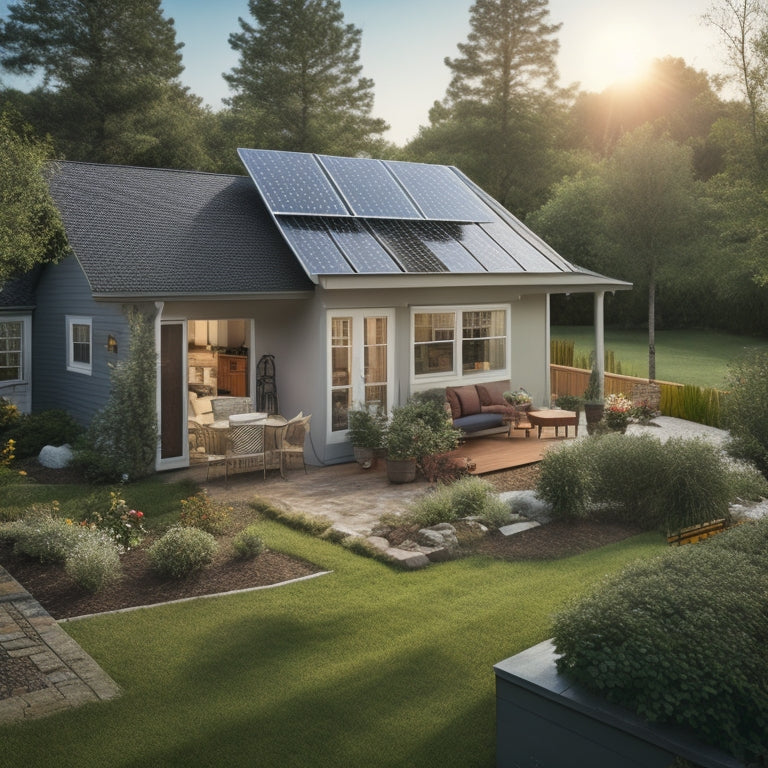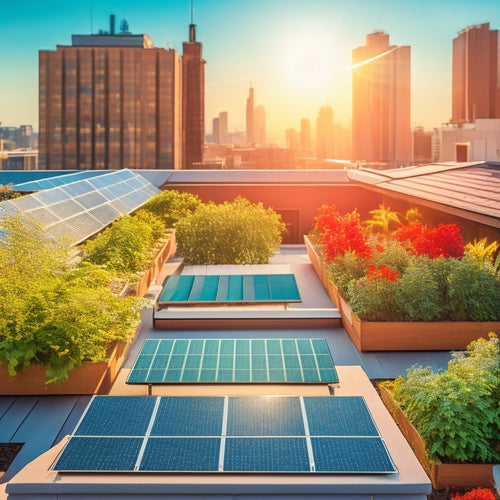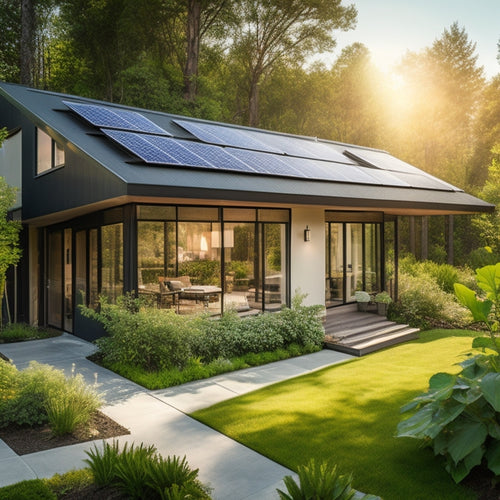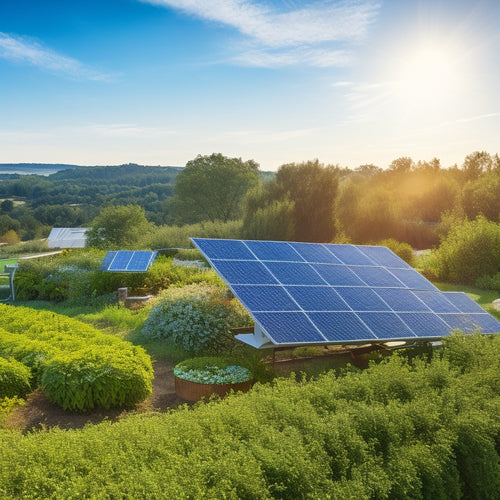
Install Your Own Solar System in 10 Steps Successfully
Share
You're taking the first step towards utilizing renewable energy by installing your own solar system. To guarantee a successful installation, start by determining your energy needs, evaluating your roof's condition, and choosing the right equipment. Design your solar panel layout, obtain necessary permits, and prepare your roof and site for installation. Then, install your solar panels and mounts, connect the electrical components, and test and inspect the system. Finally, monitor and maintain performance to optimize energy production. By following these 10 steps, you'll be well on your way to enjoying the benefits of solar energy - and there's more to investigate as you move forward with your project.
Key Takeaways
- Assess your energy needs by reviewing utility bills and understanding your motivation for switching to renewable sources.
- Ensure your roof is suitable for solar panels by checking its age, material, and structural integrity.
- Choose the right equipment, including solar panels, inverters, and mounting systems, based on efficiency, cost, and warranty.
- Design a solar panel layout that takes into account roof size and shape, orientation, and shading issues.
- Obtain necessary permits and prepare your roof and site before installation to ensure a successful and safe solar system setup.
Determine Your Energy Needs
Get a handle on your energy consumption to determine how much power your solar system needs to generate. Review your utility bills from the past year to calculate your average daily energy usage in kilowatt-hours (kWh). This will give you a clear visual representation of your energy consumption patterns.
You're likely motivated to switch to renewable sources to reduce your environmental impact and achieve energy independence. By going solar, you'll not only minimize your carbon footprint but also benefit from financial incentives like tax credits and rebates.
To guarantee a seamless changeover, consider your energy storage needs, especially if you want to maintain power during grid outages. Assess your current energy usage to determine the ideal solar technology and grid connection configuration for your system.
Assess Your Roof's Condition
Most residential roofs aren't designed to accommodate solar panels, so it's essential to evaluate your roof's condition before installing a solar system. You need to guarantee your roof can support the weight of the panels and withstand various environmental conditions.
When evaluating your roof's condition, consider the following:
-
Roof age and material: Is your roof old and worn out? Are the materials durable enough to support solar panels? Asphalt shingles, clay tiles, and metal roofs are common materials that can accommodate solar panels.
-
Structural integrity: Are there any signs of damage, such as cracks, rot, or sagging? Confirm your roof's structure can handle the additional weight of the solar panels.
-
Obstacles and shading: Are there any obstacles like skylights, vents, or chimneys that could interfere with the solar panel installation? Are there any shading issues from trees or nearby buildings that could affect the system's performance?
Choose the Right Equipment
Three key components make up a solar system: solar panels, a mounting system, and an inverter.
You'll need to choose the right solar panel type for your system, evaluating factors like efficiency ratings, cost, and warranty coverage. Monocrystalline and polycrystalline panels are popular options, but you may also reflect on thin-film or bifacial panels depending on your specific needs.
For inverter options, you'll decide between string inverters, microinverters, or power optimizers. String inverters are cost-effective, while microinverters offer more flexibility and monitoring capabilities.
You may also want to reflect on inverter options with built-in battery storage or compatibility with external batteries.
When selecting a mounting system, verify it's compatible with your roof type and solar panel brand.
You'll also need installation tools, such as a drill and wrench, to secure the system to your roof.
Evaluate cost considerations, local incentives, and maintenance requirements when making your final decisions.
Design Your Solar Panel Layout
Your solar panel layout is essential to maximizing energy production, and a well-designed system can greatly impact your return on investment.
To get it right, you'll need to evaluate several factors, including the size and shape of your roof, the direction it faces, and any obstructions that could cast shade.
Visualize your solar panel layout by imagining:
- Solar panel orientation: panels angled to face directly at the sun, capturing maximum energy.
- Panel shading analysis: identifying areas where trees, chimneys, or other obstructions might cast shade, and adjusting your layout accordingly.
- Array configuration: rows of panels strategically arranged to optimize energy production and minimize losses.
Obtain Necessary Permits
You'll need to obtain necessary permits before installing your solar system, and this involves understanding the permit application process and complying with local building codes.
You should research the specific requirements for your area, as these can vary greatly depending on where you live.
Permit Application Process
Before commencing the installation of your solar system, it's vital to obtain the necessary permits from local authorities. This guarantees that your system meets the required safety standards and complies with local regulations.
To initiate the permit application process, you'll need to gather the necessary documents and submit them to the relevant authorities. The permit requirements may vary depending on your location, so it's important to research and understand the specific requirements in your area.
Here are three key aspects to take into account during the application process:
-
Application timeline: Be prepared for a waiting period, as the permit approval process can take several weeks or even months. Plan accordingly to avoid delays in your installation schedule.
-
Permit fees: Factor in the cost of permit fees, which can range from a few hundred to several thousand dollars, depending on the complexity of your project.
-
Inspection schedules: Schedule inspections with local authorities to verify that your system meets the required safety standards and building codes.
Local Building Codes
The local building codes and ordinances governing solar system installations vary by region, and it's essential to familiarize yourself with the specific regulations in your area.
You must guarantee compliance with local regulations, which include safety standards, zoning laws, and installation guidelines. Failure to comply can result in costly delays, fines, or even system shutdown.
Obtain necessary permits by understanding the inspection procedures and contractor qualifications required in your region.
Additionally, research utility interconnection requirements to guarantee a seamless connection to the grid.
Environmental considerations, such as wildlife habitats or historic preservation areas, may also impact your installation plans.
Be aware of local funding options, such as tax incentives or rebates, that can help offset the cost of your solar system.
Prepare Your Roof and Site
You'll need to assess your roof's condition to guarantee it's structurally sound and capable of supporting the weight of the solar panels.
This involves inspecting for damaged, missing, or rotten shingles, curled or buckled shingles, and signs of animal or insect infestation.
Additionally, you'll want to evaluate your site's energy efficiency by looking at factors like tree shading, roof orientation, and potential obstructions.
Roof Condition Assessment
Evaluating your roof's condition is a critical step in preparing your site for solar installation, as it directly impacts the system's performance and longevity.
Before installing solar panels, you need to verify your roof can support the added weight and withstand various environmental conditions.
You'll want to inspect your roof for signs of damage, wear, or aging. Check for:
-
Roof material types: Is your roof made of asphalt shingles, metal, clay tiles, or something else? Different materials have varying lifespans and may require special consideration for solar installation.
-
Structural integrity assessment: Are there any signs of sagging, cracks, or weaknesses in the roof's structure? You'll need to verify your roof can support the weight of the solar panels and withstand wind, rain, and snow.
-
Age and condition: How old is your roof, and what's its current condition? If your roof is nearing the end of its lifespan, it may be more cost-effective to replace it before installing solar panels.
Site Energy Efficiency
Your roof's preparation is essential to ensuring a successful solar installation, and that's where site energy efficiency comes in. This step is important in maximizing your solar system's performance and reducing your energy consumption. Start by conducting energy audits to identify areas of energy inefficiency in your home. This will help you pinpoint opportunities for improvement, such as insulation upgrades, window replacements, and sealing air leaks.
| Energy Efficiency Measure | Benefits |
|---|---|
| Insulation Upgrades | Reduces heat loss, saves energy |
| Window Replacements | Improves natural lighting, reduces heat gain |
| Sealing Air Leaks | Prevents energy loss, improves comfort |
Install Solar Panels and Mounts
Precision is key when installing solar panels and mounts, as even the slightest misalignment can compromise energy efficiency.
You'll need to confirm that your solar panels are securely fastened to the mounting system, which is specifically designed to withstand various environmental conditions.
You'll have to decide on the type of solar panels and mounting systems that best suit your needs. Some popular solar panel types include monocrystalline, polycrystalline, and thin-film.
For mounting systems, you can choose from roof-ground, tracking, or fixed-tilt systems.
Here are three essential considerations to keep in mind:
-
Angle and orientation: Verify your solar panels are installed at the best angle and orientation to maximize energy production.
-
Structural integrity: Confirm that your mounting system can support the weight of the solar panels and withstand wind, snow, and other environmental loads.
-
Electrical connections: Make certain all electrical connections between the solar panels and mounting system are secure and meet industry standards.
Connect the Electrical Components
The electrical components of your solar system, including the inverter, charge controller, and battery bank, require careful connection to confirm efficient energy production and distribution. You'll need to ascertain that each component is compatible and properly wired to avoid safety hazards and system malfunctions.
To connect the electrical components, start by identifying the correct wiring configurations for each device. Consult the manufacturer's instructions and follow proper wiring safety protocols to avoid electrical shock or fire risks. Verify that the inverter is compatible with your solar panel array and battery bank, and that the charge controller is set to the correct voltage and amperage ratings.
| Component | Connection Type | Wiring Requirements |
|---|---|---|
| Inverter | DC-AC | 3-phase, 240V, 20A |
| Charge Controller | DC-DC | 2-wire, 12V, 10A |
| Battery Bank | DC-DC | 4-wire, 48V, 20A |
| Solar Panel Array | DC-DC | MC4 connectors, 12V, 5A |
Remember to double-check your connections before energizing the system to confirm a safe and efficient energy production.
Test and Inspect the System
You'll now need to verify that your solar system is performing as expected by checking its overall performance and verifying its energy output.
This involves conducting a series of tests to confirm the system is generating power within the expected range.
You should also inspect the system's components to identify any potential issues or defects that could impact its operation.
System Performance Check
Your solar system is installed, and it's time to put it through its paces. This vital step guarantees your system operates at peak levels, providing the power you need.
Now, inspect the system's components, paying close attention to:
-
Connectors and cables: Verify secure connections, free from signs of wear or damage.
-
Panel cleanliness: Check for dirt, debris, or shading that could impact system efficiency.
-
Inverter operation: Confirm the inverter is functioning correctly, with no error codes or alarms.
During this performance check, you're monitoring system efficiency, making sure every component works in harmony.
Performance monitoring is essential, as it identifies potential issues before they escalate. By catching problems early, you'll maximize your system's energy output and minimize downtime.
Take your time, and be thorough – your solar system's performance depends on it.
Energy Output Verification
With system components inspected and verified, it's time to put your solar system through its paces, measuring its energy output to ascertain it's generating power as expected. This vital step guarantees your system is producing energy at ideal levels, meeting your power needs efficiently.
You'll need to test the system during peak sun hours, typically between 9 am and 3 pm, to get accurate readings. Use a multimeter to measure the voltage and current output of each string and the entire system.
Compare these values to the manufacturer's specifications to verify they're within the expected range.
Efficiency measurement is essential at this stage. Calculate the system's efficiency by dividing the total energy produced by the total irradiance. This will give you a clear representation of your system's energy production capabilities.
If the values don't match the expected output, you may need to adjust the system's configuration or replace faulty components.
Monitor and Maintain Performance
How efficiently is your solar system performing? To guarantee peak energy production, you need to monitor and maintain your system's performance regularly. This involves tracking your energy consumption, inverter efficiency, and weather impacts on your system.
Here are three key aspects to focus on:
-
Performance monitoring: Use remote monitoring systems to track your energy production in real-time, identifying any deviations from expected output.
-
Maintenance schedule: Create a schedule for regular system checks, cleaning, and upgrades to prevent troubleshooting issues and guarantee peak performance.
-
Performance analytics: Analyze your system's performance data to identify areas for improvement, such as optimizing battery management or upgrading system components.
Frequently Asked Questions
Can I Install Solar Panels on a Metal Roof?
You can install solar panels on a metal roof, leveraging its advantages like durability and water-tightness, but consider special installation requirements, such as compatible mounting systems and careful sealing to guarantee a watertight seal.
Will Solar Panels Work During a Power Outage?
You'll find that solar panels alone won't provide solar energy during a power outage, as they're designed to sync with the grid; however, with a battery backup system, you'll enjoy enhanced power reliability and continuous energy supply when the grid fails.
How Long Does a Solar Panel System Last?
You can expect a solar panel system to last around 25-30 years, with some manufacturers guaranteeing up to 40 years; regular maintenance, like cleaning and inspecting, will help extend its lifespan and guarantee peak energy production.
Can I Add More Panels to My Existing System?
You can add more panels to your existing system, but verify solar panel compatibility and obtain new installation permits, as upgraded systems require re-inspection and approval to confirm peak performance and safety.
Do Solar Panels Void My Roof Warranty?
As you commence on utilizing the sun's energy, a nagging concern arises: do solar panels void your roof warranty? Fear not, for you'll find that most manufacturers provide guidelines for solar installation, ensuring roof warranty implications are minimized, and your investment remains protected.
Conclusion
You've maneuvered the 10 steps to install your own solar system, and now you're on the cusp of utilizing free energy from the sun. As you flip the switch, the silence of your new system is a stark contrast to the hum of your old electricity bill. With every kilowatt-hour generated, you're not only saving money but also reducing your carbon footprint. Congratulations, you've taken control of your energy future – and it's brighter than ever.
Related Posts
-

Solar System Installation Rebates and Tax Credits
Solar system installations offer beneficial rebates and tax credits that greatly cut your initial costs. You can bene...
-

Integrating Solar Panels Into Home Design
Integrating solar panels into your home design greatly enhances energy efficiency and lowers utility bills while addi...
-

Green Energy Alternatives for Independent Living
To enhance your independent living, consider green energy alternatives like solar panels and wind turbines. These opt...


